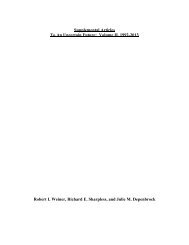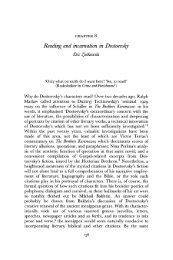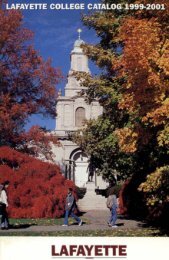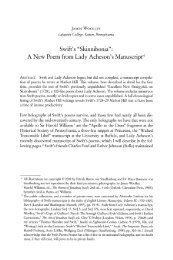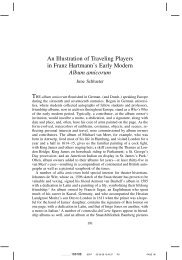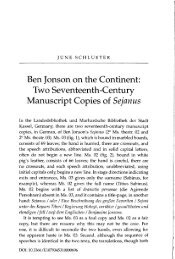Between Religion and Literature: Mircea Eliade ... - Lafayette College
Between Religion and Literature: Mircea Eliade ... - Lafayette College
Between Religion and Literature: Mircea Eliade ... - Lafayette College
Create successful ePaper yourself
Turn your PDF publications into a flip-book with our unique Google optimized e-Paper software.
<strong>Eliade</strong> <strong>and</strong> Frye<br />
constantly hearkened back to a venerable tradition of universal, systematic,<br />
<strong>and</strong> synthetic thinkers-most notably, Sir James Frazer <strong>and</strong> C. G.<br />
Jung,35 as well as, in <strong>Eliade</strong>'s case, Goethe,36 <strong>and</strong>, in Frye's case,<br />
Spengler.37 Thus both men hold their disciplines responsible, first of all,<br />
for collecting <strong>and</strong> synthesizing widely diverse materials expressive of the<br />
sacred <strong>and</strong> the imaginative. In conceiving of the history of religions as a<br />
"total" discipline, <strong>Eliade</strong> esteems it as "a Noah's Ark" stocked with "camouflaged"<br />
forms of the world's traditional religious values <strong>and</strong> models.38<br />
Similarly, Frye recommends that criticism approach literature as "the<br />
encyclopaedia of visions of human life <strong>and</strong> destiny."" 39 And if, for <strong>Eliade</strong>,<br />
historians of religions define themselves by their ability to synthesize reli-<br />
gious data into a "general perspective,""40 precisely such a general, syn-<br />
thetic perspective is implied in Frye's maxims for critically educated<br />
readers: "All themes <strong>and</strong> characters <strong>and</strong> stories that you encounter in lit-<br />
erature belong to one big interlocking family," so the value of literary<br />
studies derives from "the total body of our reading, the castle of words<br />
we've built, <strong>and</strong> keep adding new wings to all the time."4'<br />
a more centripetal movement of scholarship, trying to avoid specialization in order to articulate a<br />
number of central problems of critical theory" (Spiritus Mundi, p. 23).<br />
35 <strong>Mircea</strong> <strong>Eliade</strong> revered Frazer's The Golden Bough, despite "all its shortcomings," as a seminal<br />
classic in religious studies (Quest [n. 14 above], p. 14) <strong>and</strong> recognized it as a "cultural fashion" in<br />
itself ("Cultural Fashions <strong>and</strong> the History of <strong>Religion</strong>s," in The History of <strong>Religion</strong>s: Essays on the<br />
Problem of Underst<strong>and</strong>ing, ed. Joseph M. Kitagawa [Chicago: University of Chicago Press, 1967],<br />
pp. 25-26). On <strong>Eliade</strong>'s relation to Jung, see Mac Linscott Ricketts, "The Nature <strong>and</strong> Extent of<br />
<strong>Eliade</strong>'s 'Jungianism,"' Union Seminary Quarterly Review 25 (1970) : 234. Frye's Culture <strong>and</strong> <strong>Literature</strong><br />
(Denham, ed., n. 2 above) includes under the rubric "Grammars of the Imagination" his own<br />
review essays on Frazer ("Symbolism of the Unconscious," pp. 84-94) <strong>and</strong> Jung ("Forming<br />
Fours," pp. 117-29), along with his review of <strong>Eliade</strong>. Together with Jung's work on libido symbolism,<br />
Frye regards The Golden Bough primarily as a study in literary criticism (see Northrop<br />
Frye, "The Archetypes of <strong>Literature</strong>," in his Fables of Identity: Studies in Poetic Mythology [San<br />
Diego: Harcourt Brace Jovanovich, 1963], p. 17, Anatomy [n. 16 above], p. 109, <strong>and</strong> "<strong>Literature</strong><br />
<strong>and</strong> Myth," in Relations of Literary Study: Essays on Interdisciplinary Contributions, ed. James Thorpe<br />
[New York: Modern Language Association, 1967], p. 30). Frye, like <strong>Eliade</strong>, resists the frequent<br />
confusion of his own use of the term "archetype" with Jung's, but he acknowledges the resemblance<br />
of his own view of literature in the Anatomy toJung's m<strong>and</strong>ala vision (Spiritus Mundi [n. 15<br />
above], p. 117).<br />
36 <strong>Mircea</strong> <strong>Eliade</strong> regards Goethe, Voltaire, Da Vinci, <strong>and</strong> Giovanni Papini as representatives of<br />
the "universal spirit" (Autobiography, Volume I: 1907-1937, Journey East, Journey West, trans. Mac<br />
Linscott Ricketts [San Francisco: Harper & Row, 1981 ], p. 70), with which he himself identifies:<br />
"As always, I see Goethe's destiny as my own" (Journal II, p. 72).<br />
37 Frye ranks Spengler, with Frazer, as one of his long-time "culture-heroes" (Spiritus Mundi, p.<br />
111). See also "Spengler Revisited," ibid., pp. 179-98.<br />
38 <strong>Eliade</strong>, Labyrinth (n. 14 above), p. 149; Journal II, pp. 162-63.<br />
39 Frye, Critical Path (n. 18 above), p. 128.<br />
40 <strong>Mircea</strong> <strong>Eliade</strong>, "Methodological Remarks on the Study of Religious Symbolism," in The History<br />
of <strong>Religion</strong>s: Essays in Methodology, ed. <strong>Mircea</strong> <strong>Eliade</strong> <strong>and</strong> Joseph M. Kitagawa (Chicago: Uni-<br />
versity of Chicago Press, 1959), p. 91.<br />
'41 Northrop Frye, The Educated Imagination (Bloomington: Indiana University Press, 1964),<br />
pp. 48, 95.<br />
505



